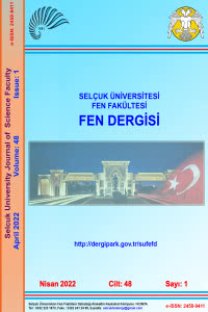DENEYSEL BİR ORGANİK RANKİNE ÇEVRİMİNDE YAPAY SİNİR AĞLARI (YSA) YARDIMIYLA GÜÇ TAHMİNİ
Organik Rankine çevrimlerinin güç tahmini için kullanılan simülasyon programlarında; sistem elamanlarının ideal yada ideale yakın olarak kabul edilen davranışlarının, gerçek davranışlarından farklı olmasından dolayı yüksek hata oranları ortaya çıkabilmektedir. Doğrusal davranışa sahip olmayan sistemlerde Yapay Sinir Ağları yöntemi ile yapılan tahminler gerçek sonuçlara daha yakın olabilmektedir. Bu çalışmada, deneysel bir organik Rankine çevrimlerinden alınan buharlaştırıcı atık ısı giriş-çıkış sıcaklıkları ile kütlesel debisi, soğuk akışkan giriş-çıkış sıcaklıkları ile kütlesel debisi öznitelikleri kullanılarak ağ eğitilmiştir. 10 kW'lık organik Rankine çevrimi için eğitilen ağ ile güç tahmini yapılarak deneysel sonuçlar ve tahmin sonuçları karşılaştırılmıştır. Çalışma sonucunda yapay sinir ağlarından elde edilen tahmin değerleri, deneysel verilerle kıyaslanmış ve tahminin performansını gösteren korelasyon katsayısı 0.99124 olarak hesaplanmıştır. Ayrıca ağa farklı deney verilerinin girişi gerçekleştirilerek ağın tahmin başarısı kontrol edilmiştir.
Power Prediction with Artificial Neural Network in Experimental Organic Rankine Cycle
In the simulation programs that used to estimate the power of the organic Rankine cycle; high error rates may have occurred due to accepting ideal or near-ideal behaviour differ from the actual behaviour of system components. Predictions made via artificial neural networks may be more close to actual results in the system which is of non-linear behaviour. In this study, network was trained by evaporator waste heat input- output temperatures and mass flow rate, cooling fluid input- output temperatures and mass flow rate taken from an experimental organic Rankine cycle. The power prediction was made with trained network and then the experimental and prediction results of the 10 kW organic Rankine cycle was compared. At the end of the study, the values obtained from artificial neural network were compared with experimental data and correlation coefficient which shows performance of network has calculated to be 0.99124. The prediction success of network was also checked via performing different test data input to the network.
___
- Dogan, E., et al. (2008) "Application of artificial neural networks to estimate wastewater treatment plant inlet biochemical oxygen demand." Environmental progress 27.4: 439-446.
- Guo, C., Du, X., Yang, L. ve Yang, Y. (2015) "Organic Rankine cycle for power recovery of exhaust flue gas", Applied Thermal Engineering, 75 (2015) 135-144.
- Huan, H, et al. (2014) "Strength Prediction of Aluminum-Stainless Steel-Pulsed TIG Welding-Brazing Joints with RSM and ANN." Acta Metallurgica Sinica (English Letters) 27.6: 1012-1017.
- Kalogirou, S. A. (1999) "Applications of artificial neural networks in energy systems." Energy Conversion and Management 40.10: 1073-1087.
- Liu, H., Tian H., Li,Y. ve Zhang, L. (2015) "Comparison of four Adaboost algorithm based artificial neural networks in wind speed prediction", Energy Conversion and Management, 92 (2015) 67-81
- Mert, I., and Arat, H. T., (2014) "Prediction of heat transfer coefficients by ANN for aluminum & steel material." International Journal 5.2: 2305-1493.
- Özden, H. ve Paul, D. (2011) "Organik Rankine çevrim teknolojisiyle düşük sıcaklıktaki kaynaktan faydalanılarak elektrik üretimi. Örnek çalışma: Sarayköy jeotermal santrali", X. Ulusal Tesisat Mühendisliği Kongresi, İzmir, 13/16 Nisan 2011, pp. 101-108.
- Sarve, Shriram, A., Sonawane, S. and Varma, M. N. (2015)."Ultrasound assisted biodiesel production from Sesame (Sesamum indicum L.) oil using Barium hydroxide as a heterogeneous catalyst: Comparative assessment of prediction abilities between Response surface methodology (RSM) and Artificial neural network (ANN)." Ultrasonics Sonochemistry
- Sözen, A., Arcaklioğlu, E. ve Özalp, M. (2003) "A new approach to thermodynamic analysis of ejector- absorption cycle: artificial neural networks", Applied Thermal Engineering, 23 (2003) 937-952.
- Taljan, G., Verbic, G., Pantos, M., Sakulin, M. ve Fickert, L. (2012) "Optimal sizing of biomass-fired organic Rankine cycle CHP system with heat storage", Renewable Energy, 41 (2012) 29-38.
- Vaja, I. ve Gambarotta, A. (2010) "Internal combustion engine (ICE) bottoming with organic Rankine cycle (ORCs)", Energy, 35 (2010) 1084-1093
- Yagli, H., Karakus, C., Koc, A., Pulyaev, S. and Akgöz, O. (2013) "Usability of waste heat by organic Rankine cycle and exergy analysis", Proceeding of the UTES'2013 IX. Clean Energy Symposium, Konya, Turkey, pp.394-401.
- Zhang, G., Patuwo, B.E. ve Hu, M.Y., "Forecasting with artificial neural networks: the state of the art", Int. Journal of Forecasting, 14 (1998) 35-62.
- ISSN: 2147-9364
- Yayın Aralığı: Yılda 2 Sayı
- Başlangıç: 2013
- Yayıncı: Selçuk Üniversitesi Mühendislik Fakültesi
Sayıdaki Diğer Makaleler
Co-B-F ve Co-B-P KATALİZÖRLERİ KULLANILARAK NaBH4'DEN HİDROJEN ÜRETİMİNE NaOH'İN ETKİSİ
MEHMET SAİT İZGİ, Ömer ÖDEMİŞ, ÖMER ŞAHİN, CAFER SAKA
DENEYSEL BİR ORGANİK RANKİNE ÇEVRİMİNDE YAPAY SİNİR AĞLARI (YSA) YARDIMIYLA GÜÇ TAHMİNİ
Hasan HÜSEYİN BİLGİÇ, HÜSEYİN YAĞLI, ALİ KOÇ, AHMET YAPICI
LOGARİTMİK KUVVETLENDİRİCİLERLE GERÇEKLEŞTİRİLEN ANALOG KAREKÖK ALICI
FİRMA FAALİYET SINIRLARI PROBLEMİ İÇİN BÜTÜNLEŞİK BİR YAKLAŞIM GELİŞTİRİLMESİ
ANTAKYA KÖRFEZİ DENİZ ÜSTÜ RÜZGÂR ENERJİSİ POTANSİYEL ARAŞTIRILMASI
